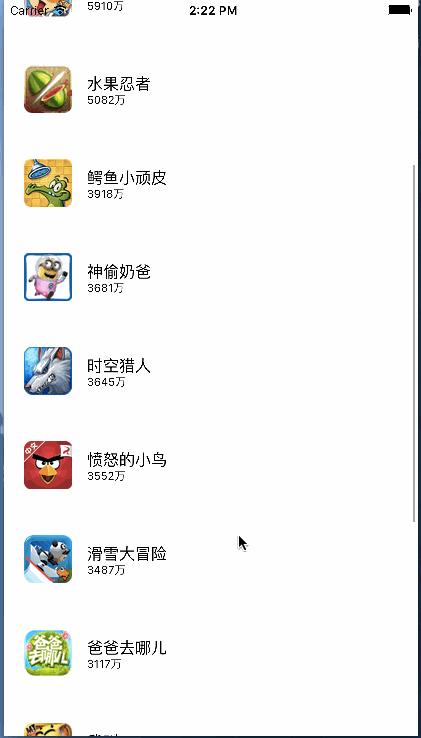展示效果如下: 大家可以看到這個界面很簡單,其實就是UITableView的佈局, 但是難點是在於如何從網上下載這些圖片,下載之後應如何進行存儲! 我們一步一步進行解析,先從單線程(主線程)進行多圖片下載 我們佈局上的文字及圖片的地址從plist文件中進行讀取 根據結構,我們自定義一個數據模型文件 ...
展示效果如下:

大家可以看到這個界面很簡單,其實就是UITableView的佈局,
但是難點是在於如何從網上下載這些圖片,下載之後應如何進行存儲!
我們一步一步進行解析,先從單線程(主線程)進行多圖片下載
我們佈局上的文字及圖片的地址從plist文件中進行讀取

根據結構,我們自定義一個數據模型文件
DDZApp.h
#import <Foundation/Foundation.h> @interface DDZApp : NSObject //圖標 @property (nonatomic,strong) NSString *icon; //名字 @property (nonatomic,strong) NSString *name; //下載量 @property (nonatomic,strong) NSString *download; + (instancetype)appWithDict:(NSDictionary *)dict; @end
DDZApp.m
#import "DDZApp.h" @implementation DDZApp + (instancetype)appWithDict:(NSDictionary *)dict { DDZApp *app = [[self alloc] init]; [app setValuesForKeysWithDictionary:dict]; return app; } @end
以下的都是視圖控制器中的代碼
ViewController.m
1.
@interface ViewController () //所有數據 @property (nonatomic,strong)NSArray *apps; //記憶體緩存圖片 @property (nonatomic,strong)NSMutableDictionary *imgCache; @end
第一個屬性用於存儲讀取plist文件中的內容,設置為屬性保存起來,就可以不用重覆讀取
第二個屬性用於保存從網上下載下來的圖片,也是為了不用重覆讀取
2.
@implementation ViewController //讀取數據 - (NSArray *)apps { if (!_apps) { //從plist文件中讀取數據 NSArray *dictArray = [NSArray arrayWithContentsOfFile:[[NSBundle mainBundle] pathForResource:@"apps.plist" ofType:nil]]; NSMutableArray *appArray = [NSMutableArray array]; for (NSDictionary *dict in dictArray) { [appArray addObject:[DDZApp appWithDict:dict]]; } _apps = appArray; } return _apps; } //緩存圖片 - (NSMutableDictionary *)imgCache { if (!_imgCache) { //初始化 _imgCache = [NSMutableDictionary dictionary]; } return _imgCache; }
這兩個方法都是為了初始化剛纔的兩個屬性
3.

#pragma mark - 數據源方法 - (NSInteger)tableView:(UITableView *)tableView numberOfRowsInSection:(NSInteger)section { return self.apps.count; } - (UITableViewCell *)tableView:(UITableView *)tableView cellForRowAtIndexPath:(NSIndexPath *)indexPath { static NSString *ID = @"app"; UITableViewCell *cell = [tableView dequeueReusableCellWithIdentifier:ID]; DDZApp *app = self.apps[indexPath.row]; cell.textLabel.text = app.name; cell.detailTextLabel.text = app.download; //先從記憶體中取出圖片 UIImage *image = self.imgCache[app.icon]; if (image) { cell.imageView.image = image; }else { //記憶體中沒有圖片 //將圖片文件數據寫入到沙盒中 NSString *cachesPath = [NSSearchPathForDirectoriesInDomains(NSCachesDirectory, NSUserDomainMask, YES) firstObject]; //獲得文件名 NSString *filename = [app.icon lastPathComponent]; //計算出文件的全路徑 NSString *file = [cachesPath stringByAppendingPathComponent:filename]; //載入沙盒的文件數據 NSData *data = [NSData dataWithContentsOfFile:file]; //判斷沙盒中是否有圖片 if (data) { //直接載入沙盒中圖片 cell.imageView.image = [UIImage imageWithData:data]; //存到字典(記憶體)中 self.imgCache[app.icon] = cell.imageView.image; }else { //下載圖片 data = [NSData dataWithContentsOfURL:[NSURL URLWithString:app.icon]]; cell.imageView.image = [UIImage imageWithData:data]; //存到記憶體中 self.imgCache[app.icon] = cell.imageView.image; //將圖片數據寫入到沙盒中 [data writeToFile:file atomically:YES]; } } return cell; }View Code
這兩個方法是UITableView必須要實現的方法
第一個是返回數據量,沒什麼好說的
第二個是綁定數據
具體的流程看下圖




